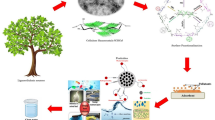Abstract
Alkali cellulose is an important intermediate in the production of cellulose derivatives. N-methylmorpholine-N-oxide (NMMO)/H2O was used as a homogeneous reaction medium for the cellulose alkalization process to intensify the alkalization degree and improve the substitution uniformity. The morphology, specific surface area and crystalline structure of pristine cellulose, the as-synthesized alkali cellulose and dissolved-regenerated cellulose were characterized by SEM, BET, XRD and FT-IR, respectively. The results showed that the homogeneous reaction medium not only offered a low mass transfer resistance, but also facilitated a disruption of the hydrogen bond in cellulose, thus resulting in the transformation of the cellulose structure from complicated stacking chains to simple glucose chains. The interior hydroxyl groups in the cellulose became accessible to the alkaline reagent NaOH to enhance the alkalization process for the increase in bonding alkali content and the improvement in substitution uniformity. The bonding alkali content was calculated by the difference between total added alkali and free alkali and was achieved as 0.61 g/g cellulose at the optimized operation conditions: reaction temperature of 95 °C, reaction time of 90 min, NMMO dosage of 90.00 g, cellulose 1.0 g and NaOH concentration of 1.40 wt%. Meanwhile, in the conventional alkalization process, the bonding alkali content was just 0.41 g/g cellulose. The alkali cellulose prepared in NMMO/H2O medium has a large specific surface area of 125 m2 g−1 and an extremely low crystallinity degree. The NMMO/H2O system represents a potential homogeneous solvent for the cellulose alkalization process.









Similar content being viewed by others
References
Cipriani G, Salvini A, Baglioni P, Bucciarelli E (2010) Cellulose as a renewable resource for the synthesis of wood consolidants. J Appl Polym Sci 118:2939–2950
Focher B, Palma MT, Canetti M, Torri G, Cosentino C, Gastaldi G (2001) Structural differences between non-wood plant celluloses: evidence from solid state NMR, vibrational spectroscopy and X-ray diffractometry. Ind Crops Prod 13:193–208
French AD (2014) Idealized powder diffraction patterns for cellulose polymorphs. Cellulose 21:885–896
Heinze T, Liebert T, Klufers P, Meister F (1999) Carboxymethylation of cellulose in unconventional media. Cellulose 6:153–165
Heinze T, Schwikal K, Barthel S (2005) Ionic liquids as reaction medium in cellulose functionalization. Macromol Biosci 5:520–525
Heinze T, Lincke T, Fenn D, Koschella A (2008) Efficient allylation of cellulose in dimethyl sulfoxide/tetrabutylammonium fluoride trihydrate. Polym Bull 61:1–9
Isogai A, Ishizu A, Nakano J (1984a) Preparation of tri-o-benzylcellulose by the use of nonaqueous cellulose solvents. J Appl Polym Sci 29:2097–2109
Isogai A, Ishizu A, Nakano J (1984b) Preparation of tri-o-substituted cellulose ethers by the use of a nonaqueous cellulose solvent. J Appl Polym Sci 29:3873–3882
Ke H, Zhou J, Zhang L (2006) Structure and physical properties of methylcellulose synthesized in NaOH/urea solution. Polym Bull 56:349–357
Klemm D, Heublein B, Fink HP, Bohn A (2005) Cellulose: fascinating biopolymer and sustainable raw material. Angew Chem Int Ed 44(22):3358–3393
Lin MS, Huang CS (1992) Syntheses and characterizations of allyl cellulose and glycidyl cellulose. J Polym Sci Polym Chem 30:2303–2312
Nahla A, Wakil E, Mohammad L et al (2008) Structural changes of regenerated cellulose dissolved in FeTNa, NaOH/thiourea, and NMMO systems. J Appl Polym Sci 109:2862–2871
Olsson AM, Salmen L (2004) The association of water to cellulose and hemicellulose in paper examined by FTIR spectroscopy. Carbohyd Res 339:813–818
Qi H, Liebert T, Meister F, Heinze T (2009) Homogenous carboxymethylation of cellulose in the NaOH/urea aqueous solution. React Funct Polym 69:779–784
Qi H, Liebert T, Meister F, Zhang L, Heinze T (2010) Homogenous carboxymethylation of cellulose in the new alkaline solvent LiOH/Urea aqueous solution. Macromol Symp 294(2):125–132
Qi H, Liebert T, Heinze T (2012) Homogenous synthesis of 3-allyloxy-2-hydroxypropyl-cellulose in NaOH/urea aqueous system. Cellulose 19:925–932
Ramos LA, Frollini E, Heinze T (2005) Carboxymethylation of cellulose in the new solvent dimethyl sulfoxide/tetrabutylammonium fluoride. Carbohyd Polym 60:259–267
Rosenau T, Potthast A, Sixta H, Kosma P (2001) The chemistry of side reactions and byproduct formation in the system NMMO/cellulose (Lyocell process). Prog Polym Sci 26:1763–1837
Rosenau T, Potthast A, Adorjian I, Hofinger A, Sixta H, Firgo H, Kosma P (2002) Cellulose solutions in N-methylmorpholine-N-oxide (NMMO) degradation processes and stabilizers. Cellulose 9:283–291
Sachinvala ND, Winsor DL, Hamed OA et al (2000) The physical and NMR characterizations of allyl- and crotylcelluloses. J Polym Sci Polym Chem 38:1889–1902
Sang YO, Dong IY, Younsook S et al (2005) Crystalline structure analysis of cellulose treated with sodium hydroxide and carbon dioxide by means of X-ray diffraction and FTIR spectroscopy. Carbohyd Res 340:2376–2391
Schwanninger M, Rodrigues JC, Pereira H, Hinterstoisser B (2004) Effects of short-time vibratory ball milling on the shape of FT-IR spectra of wood and cellulose. Vib Spectrosc 36:23–40
Shao ZQ, Wang JF (2007) Cellulose ethers. Chemical Industry Press, Beijing
Song Y, Sun Y, Zhang X, Zhou J, Zhang L (2008) Homogeneous quaternization of cellulose in NaOH/urea aqueous solutions as gene carriers. Biomacromolecules 9:2259–2264
Yuan LT, Wang Y, Wan JQ, Ma YW, Huang MZ (2014) Supramolecular structure analysis of recycled eucalyptus fibers by fourier transform infrared spectrometer and solid state nuclear magnetic resonance. Polym Mater Sci Eng 30(6):48–53
Zhang L, Cai J, Zhou J (2005) Novel solvent compounds and its preparation and application. CN 03128386.1
Zhang H, Yan Q, Meng J et al (2014) Structure and properties of the cellulose film grafted with silicone. J Cellul Sci Technol 22(2):22–29
Zhou J, Zhang L, Deng Q, Wu X (2004) Synthesis and characterization of cellulose derivatives prepared in NaOH/urea aqueous solutions. J Polym Sci Polym Chem 42(23):5911–5920
Zhou J, Qin Y, Liu S, Zhang L (2006) Homogeneous synthesis of hydroxyethlcellulose in NaOH/urea aqueous solution. Macromol Biosci 6(1):84–89
Acknowledgments
We are grateful for the financial support from the National Natural Science Foundation of China (nos. 21276163, 21576168) and the Key Technology Research and Development Program of Sichuan Province (2014GZ0058).
Author information
Authors and Affiliations
Corresponding author
Rights and permissions
About this article
Cite this article
Zhang, Y., Tang, S. & Zhang, T. Homogeneous alkalization of cellulose in N-methylmorpholine-N-oxide/water solution. Cellulose 24, 1235–1245 (2017). https://doi.org/10.1007/s10570-017-1195-z
Received:
Accepted:
Published:
Issue Date:
DOI: https://doi.org/10.1007/s10570-017-1195-z




